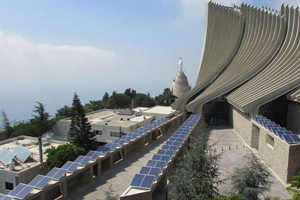|
| Public and private facilities go solar |
| Solar generated power finally being seen as alternative to power outages |
|
 |
More public and private facilities, touristic sites, and syndicates are leaning toward solar power to offset public electricity cutoffs.
The Chamber of Commerce, Industry, and Agriculture in Tripoli and the North revealed its intentions to build a solar plant on top of its building to light up the highway from the city's entrance to Bchara el Khoury and Achir el Daya streets. The project, valued at $350,000, is in its tendering phase. Among the latest entities also to adopt renewable energy is the bar syndicate of Beirut. The syndicate signed an agreement with the Lebanese Center for Energy Conservation (LCEC) to turn the building into a sustainable one using renewable energy.
Rabih Osta, General Manager of Phoenix Energy, an Indevco subsidiary, said: "Three factors contribute to the big progress in the solar market: The launch of public bids, the NEEREA financing mechanism, and competition growth." The National Energy Efficiency and Renewable Energy Action (NEEREA) program grants 14-year loans to the private sector with near zero interest. Since the program's launch in 2011, 256 loans with a value of $380 million have been approved, creating 6,000 jobs. "Competition helped reduce the selling price of solar power products and improve suppliers' technical skills," he said.
ECOsys, a subsidiary of Information Technology Group (ITG) Holding, has won the tender to install 1.1 megawatt of solar power to operate the Zahrani Oil Installations (ZOI). The Beirut River Solar Snake, another operation by Phoenix Energy, saw the installation of solar panels across 20,000 square meters over the river's bed, generating 1 MW of electricity.
Phoenix Energy also installed solar panels at Harissa Our Lady of Lebanon. Osta said: "Religious facilities are very interested in this technology. We are receiving plenty of requests from convents and Christian schools." The company just won a $70 million project to install 200,000 solar panels in Egypt. |
| |
|
|

